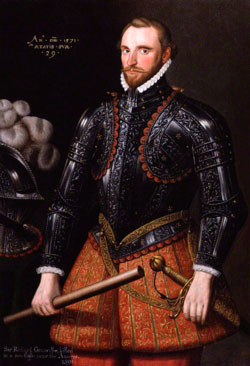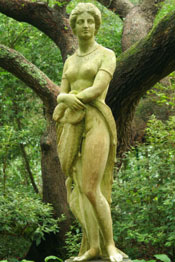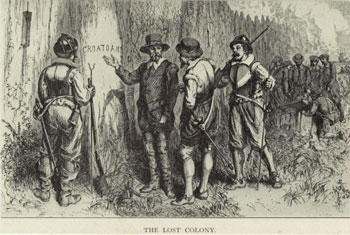Small Planet Communications, Inc. + 300 Brickstone Square, Andover, MA 01810 + (978) 794-2201 + Contact







Roanoke was intended to be the first permanent English settlement in North America, but the colonists there vanished in a cloud of mystery.

Read a biography of Sir Richard Grenville.
The first effort to establish an English colony in the New World was led by Sir Richard Grenville in the spring of 1585. Cousin to Sir Walter Raleigh, who initially secured the patent to colonize America from Queen Elizabeth I, Grenville left more than 100 men on Roanoke Island, before returning to England for more supplies. Among the colonists were Governor Ralph Lane and John White, who served as the expedition's artist and cartographer.
The group explored the area, impressed by the abundance of fruit and natural resources. After securing supplies to get them through the winter, they continued their exploration of the area, searching for pearls and gold. Relations with the American Indians were friendly at first, leaving the colonists to mistakenly assume they could rely on them for help and supplies throughout the winter. However, conflict soon developed between the colonists and the American Indians. During this time, the colonists burned an American Indian village and destroyed the standing corn on suspicion of the theft of a silver cup.
Read Governor Ralph Lane's report
about the first Roanoke settlement,
written in 1586.
Struggling through the harsh winter and growing impatient for the overdue arrival of Grenville, the settlers faced starvation. The following June, the colonists took the opportunity to return to England with Sir Francis Drake, who unexpectedly stopped at the island following a raid against Spain's New World colonies to the south. Two weeks later, Grenville arrived at Roanoke with supplies and 15 additional colonists. Finding no trace of the previous group of settlers, he left these men on Roanoke to hold the position until reinforcements could be brought from England.
The second attempt to colonize Roanoke Island was led by John White, named governor of a new colony to be established north of Roanoke on Chesapeake Bay. On May 8, 1587, White left Portsmouth, England, with three ships carrying supplies and 150 colonists, including women and children. One passenger was Governor White's daughter, Eleanor, who was pregnant at the time of voyage. On July 22 the expedition reached Roanoke, where White planned to pick up the 15 men left behind the previous year before continuing north to Chesapeake Bay to found his colony. Of the 15 men left behind, however, only the bones of one were found. The fort had been razed, but some houses, though overgrown with vines and infested with wildlife, were still standing. White was anxious to move on but was blocked by the expedition's nautical leader, a Portuguese pilot named Simon Fernandez. White and Fernandez had had difficult relations during the three-month-long voyage, and now Fernandez announced that he was unloading the settlers at Roanoke and would return to England in the largest of the three ships.
DID YOU KNOW?
In August 1587, Virginia Dare
was the first child born to
English parents in the New
World. She was the
granddaughter of Governor
John White.
It was too late in the year to plant crops, so the colonists had to depend on the generosity of local American Indians. But they, too, had left Roanoke and moved to the mainland, upset by the behavior of the English who had arrived earlier. It was decided that White would leave one of the two remaining small ships with the settlers while he returned once again to England for supplies in the third ship. If the colonists moved north to Chesapeake Bay in their ship, they agreed to leave a small party on Roanoke to direct White to the new settlement upon his return in six months.
When White reached England, however, he found the country absorbed in war with Spain. It was three years before Sir Walter Raleigh managed to get the governor onto the privateer Hopewell and load it and three smaller ships with provisions for the stranded colonists.
On August 17, 1590, almost three years to the day since he had left, White returned to Roanoke. Seeing smoke rising from the island, the ship's passengers thought this meant good news for the colonists who had been left behind. They shouted and played English tunes on trumpets in celebration and greeting. Going farther ashore at the northern tip of the island, however, they found the settlement deserted. The smoke came from an untended brush fire.

Only the word Croatoan carved into a tree gives any clue
as to what happened to the Lost Colony.
Where had the colonists of 1587 gone? There was a clue: On a tree at the entrance to the palisade built around the settlement, the word CROATOAN had been carved in capital letters; on another tree by the road leading to the mooring place, the three letters CRO were carved—most likely an abbreviation of the first. It has been speculated that the group moved to Croatoan, an island 50 miles to the south, where American Indians who were friendly with colonists lived. The colonists had agreed beforehand to leave a sign in a prominent place giving their destination if they had to abandon Roanoke Island. Should they be in danger, they were to add a Maltese Cross to the sign. Since there was no cross on either sign, it seemed the group had made the move voluntarily.
White wanted to sail on to Croatoan Island immediately. But the weather took a turn for the worse, and the Hopewell broke loose from its anchor and began drifting out to sea. Because of this danger, the short voyage to Croatoan was never made, and the two ships set sail for England. By October 24, White was back in England.
None of the men, women, and children left on Roanoke Island in 1587 were ever seen again. Some historians theorize that the Spaniards sailed north and murdered them; others claim American Indians killed them. Most likely, the larger number of Roanoke settlers followed the original plan and moved north to settle near the entrance to Chesapeake Bay. Chesapeake Indians living there may have given the colonists some protection from the enemy natives led by Chief Powhatan, who lived farther north and west.
A small group of settlers, however, may have remained at Roanoke for a while, as agreed. Perhaps threatened by American Indians, fearful of the Spaniards, and despairing of White's return, they moved south to Croatoan. As more years passed, they may have adapted to the lifestyle of the American Indians there. In late 1590, White tried to persuade Raleigh and other investors to sponsor another expedition to locate the missing colonists. He was unsuccessful.
Click to learn more
about the search for the
lost colony.
On May 14, 1607, the first permanent English settlement was successfully established at nearby Jamestown. Its settlers found no trace of the Roanoke colonists, due mostly to the fact that the investigation was launched twenty years after the colonists were last seen. The fate of the Lost Colony at Roanoke Island still remains one of Colonial America's great mysteries.
Roanoke | Bibliography
- Lane, Ralph. "The Colony at Roanoke." 1586. National Center for Public Policy Research. Accessed 5/29/19. http://www.nationalcenter.org/
ColonyofRoanoke.html - National Park Service. "Teacher Handbook to Roanoke Revisited." Accessed 5/29/19. https://www.nps.gov/fora/learn/education/teacher-handbook-to-roanoke-revisited.htm
- National Park Service. "Fort Raleigh." Accessed 5/29/19. https://www.nps.gov/fora/index.htm
- NCpedia.org. "Colonial Period." Accessed 5/29/19. http://ncpedia.org/history/colonial
Roanoke | Image Credits
- Sir Richard Grenville | Artist: Unknown, 1571; National Portrait Gallery, London
- Virginia Dare | Artist: Maria Louisa Lander, 1859; photo by Tania Gail, 2007; Flickr
- The Lost Colony | Artist: Unknown, 1900; NYPL Digital Gallery
© 2020 Small Planet Communications, Inc. + Terms/Conditions + 300 Brickstone Square, Andover, MA 01810 + (978) 794-2201 + Contact
